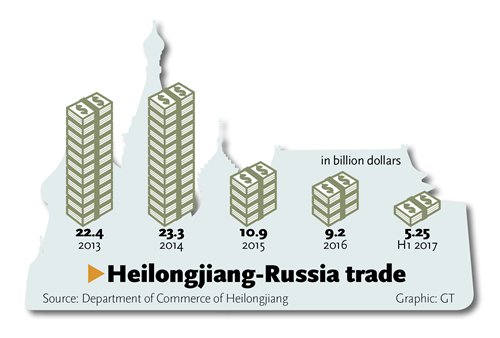
Source: Department of Commerce of Heilongjiang Graphic: GT
Growing interest
Efforts are continuing to further open up and boost trade volume between China and Russia.
In the first six months, the trade volume between Heilongjiang and Russia grew 25.4 percent year-on-year to $5.25 billion, Qiu Rui, an official from the local department of commerce, told the Global Times on Monday.
"The local government has encouraged diversified imports from Russia by setting up 11 border trading areas last year, eight of which have already become operational," Qiu noted.
Local authorities approved imports of frozen fish from Sakha Republic at the beginning of this year, and more Russian seafood is expected to enter the Chinese market in the coming months, according to You.
The authorities unveiled guidelines for border trade in the province in July 2016, capping the number of traders and lifting tariffs on more than 8,000 yuan worth of goods each day. The move is intended to facilitate border trading activities, according to a document on the website of the local government.
"This gives more room for the growth of imported consumer goods from Russia," Qiu noted.
Trade issues
While trade is booming, there are still some challenges.
After authorities in the province opened up local markets to Russian products, business representatives in Heilongjiang raised concerns over the quality of some of the imports and the risk of vicious competition.
"Some daigou [traveling shopping agents] still exist in border towns, and it is hard to ensure the authenticity of some so-called Russian products that are shipped through non-official channels and that are sold at much lower prices," Sun noted.
With more Russian imports expected to pour into the Chinese market, local authorities should come up with related regulations to crack down on fake goods, according to business representatives.
Furthermore, the boom in trade of consumer products only accounts for a small portion of the overall bilateral trade and might not help with Heilongjiang's trade deficit with Russia, according to officials.
"The trade deficit is likely to remain, at least for the short term, because the province is not export-driven and imports make up over 80 percent of the total trade," Qiu noted.


















































